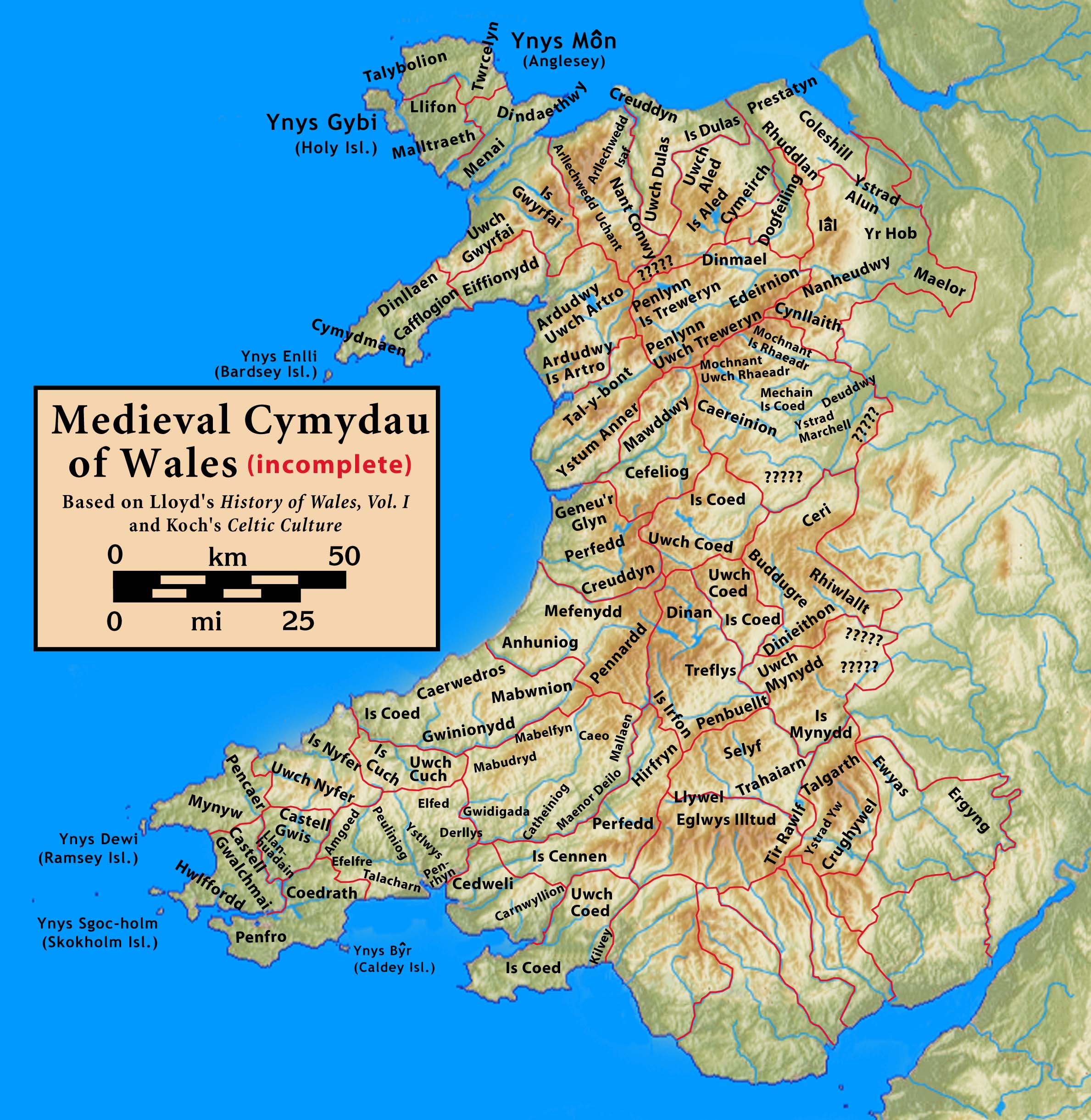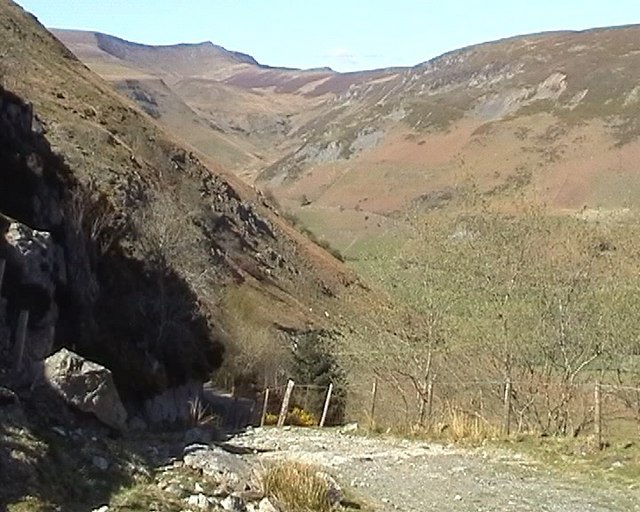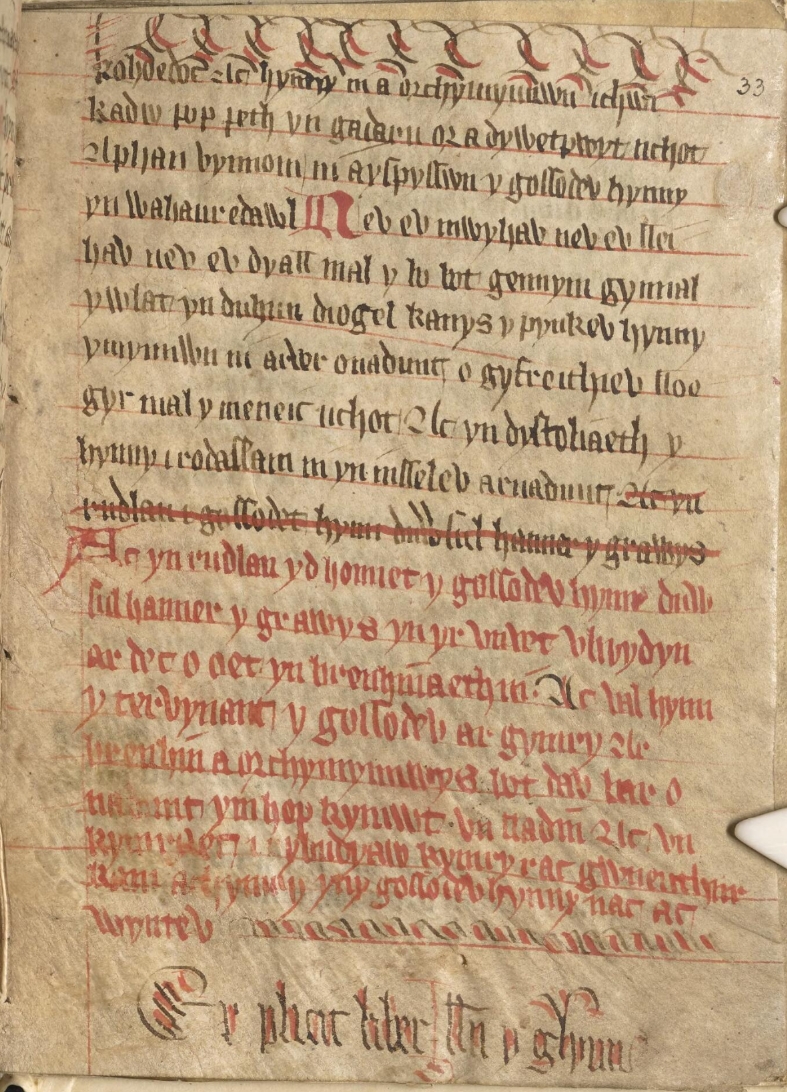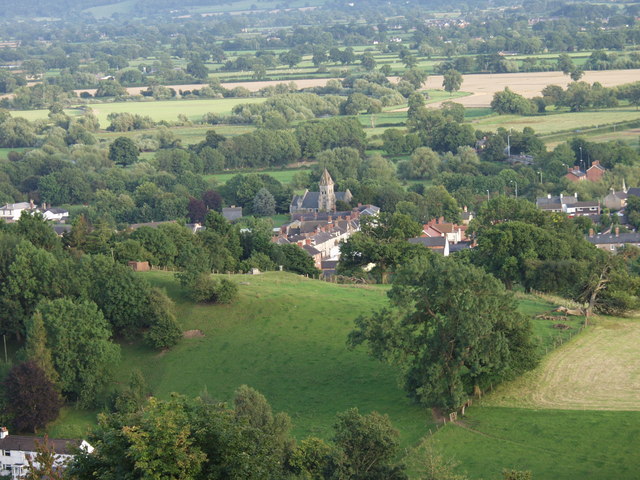|
Penllyn (cantref)
Penllyn (head of the lake i.e. Bala Lake or ) was a medieval cantref originally in the Kingdom of Powys but annexed to the Kingdom of Gwynedd. It consisted of the commotes () of Edeyrnion, Dinmael, and ( signifying 'below' and 'above' the River Tryweryn). On the north and west it bordered Gwynedd (the cantrefi of Tegeingl, Rhufoniog, Dunoding and Meirionydd); it bordered the Powys cantrefi of Maelor, Mochnant and Cyfeiliog on the east and south. After the death of Madog ap Maredudd, the last Prince of the whole of Powys, and his eldest son and heir in 1160, the kingdom was divided between his surviving sons Gruffydd Maelor, Owain Fychan and Owain Brogyntyn, his nephew Owain Cyfeiliog and his half-brother Iorwerth Goch. Penllyn was inherited by Owain Brogyntyn; Edeyrnion had been the home of his mother (who was not married to his father) and he may also have been raised there. The military skill and strength of Madog had prevented Gwynedd from asserting hegemony over Powys, ... [...More Info...] [...Related Items...] OR: [Wikipedia] [Google] [Baidu] |
Wales
Wales ( cy, Cymru ) is a Countries of the United Kingdom, country that is part of the United Kingdom. It is bordered by England to the Wales–England border, east, the Irish Sea to the north and west, the Celtic Sea to the south west and the Bristol Channel to the south. It had a population in 2021 of 3,107,500 and has a total area of . Wales has over of coastline and is largely mountainous with its higher peaks in the north and central areas, including Snowdon (), its highest summit. The country lies within the Temperateness, north temperate zone and has a changeable, maritime climate. The capital and largest city is Cardiff. Welsh national identity emerged among the Celtic Britons after the Roman withdrawal from Britain in the 5th century, and Wales was formed as a Kingdom of Wales, kingdom under Gruffydd ap Llywelyn in 1055. Wales is regarded as one of the Celtic nations. The Conquest of Wales by Edward I, conquest of Wales by Edward I of England was completed by 1283, th ... [...More Info...] [...Related Items...] OR: [Wikipedia] [Google] [Baidu] |
Mochnant
Mochnant, a name translating as "the rapid stream", was a medieval cantref in the Kingdom of Powys. In the 12th century it was divided into the commotes of Mochnant Is Rhaeadr (in the north) and Mochnant Uwch Rhaeadr (in the south) (''Is'' signifying 'below' and ''Uwch'' 'above' the River Rhaeadr). Its north-west border was with the cantref of Penllyn, originally in Powys but which became annexed to the Kingdom of Gwynedd during the time of Owain Brogyntyn. It bordered the cantrefi of Caereinion and Mechain to the south, and Maelor to the north-east. The administrative centre was Llanrhaeadr-ym-Mochnant in Mochnant Is Rhaeadr. After the death of Madog ap Maredudd and his eldest son and heir in 1160, the kingdom was divided up between his surviving sons Gruffydd Maelor, Owain Fychan and Owain Brogyntyn, his nephew Owain Cyfeiliog and his half-brother Iorwerth Goch. Mochnant was initially given to Iorwerth Goch, but in 1166 he was ejected by Owain Cyfeiliog and Owain Fychan, wh ... [...More Info...] [...Related Items...] OR: [Wikipedia] [Google] [Baidu] |
Merionethshire
, HQ= Dolgellau , Government= Merionethshire County Council (1889-1974) , Origin= , Status= , Start= 1284 , End= , Code= MER , CodeName= Chapman code , Replace= Meirionnydd , Motto= Tra môr, tra Meirion (While the sea lasts, so shall Meirionnydd) , Divisions= , DivisionsNames= , DivisionsMap= , Image= Flag of Merionethshire , Map= , Arms= ''Coat of arms of Merionethshire County Council'' , Civic= , PopulationFirst= 35,315Vision of Britain 1831 Census/ref> , PopulationFirstYear= 1831 , AreaFirst= , AreaFirstYear= 1831 , DensityFirst= 0.1/acre , DensityFirstYear= 1831 , PopulationSecond= 45,565 , PopulationSecondYear= 1911 , AreaSecond= , AreaSecondYear= 1911/1961 , DensitySeco ... [...More Info...] [...Related Items...] OR: [Wikipedia] [Google] [Baidu] |
Statute Of Rhuddlan
The Statute of Rhuddlan (12 Edw 1 cc.1–14; cy, Statud Rhuddlan ), also known as the Statutes of Wales ( la, Statuta Valliae) or as the Statute of Wales ( la, Statutum Valliae, links=no), provided the constitutional basis for the government of the Principality of Wales from 1284 until 1536. The Statute introduced English common law to Wales, but also permitted the continuance of Welsh legal practices within the Principality. The Statute was superseded by the Laws in Wales Acts 1535 and 1542 when Henry VIII made Wales unequivocally part of the "realm of England".The Laws in Wales Act 1535 () The statute was not an act of Parliament, but rather a royal ordinance made after careful consideration by Edward I on 3 March 1284. It takes its name from Rhuddlan Castle in Denbighshire where it was first promulgated on 19 March 1284. It was formally repealed by the Statute Law Revision Act 1887. Background The Prince of Gwynedd had been recognised by the English Crown as Prince of W ... [...More Info...] [...Related Items...] OR: [Wikipedia] [Google] [Baidu] |
Vassal
A vassal or liege subject is a person regarded as having a mutual obligation to a lord or monarch, in the context of the feudal system in medieval Europe. While the subordinate party is called a vassal, the dominant party is called a suzerain. While the rights and obligations of a vassal are called vassalage, and the rights and obligations of a suzerain are called suzerainty. The obligations of a vassal often included military support by knights in exchange for certain privileges, usually including land held as a tenant or fief. The term is also applied to similar arrangements in other feudal societies. In contrast, fealty (''fidelitas'') was sworn, unconditional loyalty to a monarch. European vassalage In fully developed vassalage, the lord and the vassal would take part in a commendation ceremony composed of two parts, the homage and the fealty, including the use of Christian sacraments to show its sacred importance. According to Eginhard's brief description, the ''commenda ... [...More Info...] [...Related Items...] OR: [Wikipedia] [Google] [Baidu] |
Hegemony
Hegemony (, , ) is the political, economic, and military predominance of one State (polity), state over other states. In Ancient Greece (8th BC – AD 6th ), hegemony denoted the politico-military dominance of the ''hegemon'' city-state over other city-states. In the 19th century, ''hegemony'' denoted the "social or cultural predominance or ascendancy; predominance by one group within a society or milieu" and "a group or regime which exerts undue influence within a society". In cultural imperialism, the leader state dictates the internal politics and the Society, societal character of the subordinate states that constitute the hegemonic sphere of influence, either by an internal, sponsored government or by an external, installed government. The term ''hegemonism'' denoted the geopolitical and the cultural predominance of one country over other countries, e.g. the hegemony of the Great power, Great Powers established with European colonialism in Africa, Asia, and Latin America. I ... [...More Info...] [...Related Items...] OR: [Wikipedia] [Google] [Baidu] |
Iorwerth Goch Ap Maredudd
Iorwerth Goch ap Maredudd (c. 1110 – c. 1171), a minor prince and nobleman of the Kingdom of Powys, was the illegitimate son of Maredudd ap Bleddyn and Cristin ferch Bledrus. The appellation "Goch", meaning red, probably referred to the colour of his hair. Iorwerth married Maud de Manly, who gave him two sons, Gruffydd Fychan (c. 1150), and Hywel ap Iorwerth He had one brother, Hywel ap Maredudd, and two half-brothers, Madog ap Maredudd and Gruffydd ap Maredudd. Iorwerth is known to have taken Tomen y Rhodwydd, Llandegla, Denbighshire (a castle built by Owain Gwynedd in 1149) in 1157 and burnt it down. ''The Dream of Rhonabwy'' in the ''Mabinogion The ''Mabinogion'' () are the earliest Welsh prose stories, and belong to the Matter of Britain. The stories were compiled in Middle Welsh in the 12th–13th centuries from earlier oral traditions. There are two main source manuscripts, create ...'' mentions Iorwerth: " is brother, Iorwerth son of Maredudd, was extremely agitated ... [...More Info...] [...Related Items...] OR: [Wikipedia] [Google] [Baidu] |
Owain Cyfeiliog
Owain ap Gruffydd (c. 1130–1197) was a prince of the southern part of Powys and a poet. He is usually known as Owain Cyfeiliog to distinguish him from other rulers named Owain, particularly his contemporary, Owain ap Gruffydd of Gwynedd, who is known as Owain Gwynedd. Owain was the son of Gruffydd ap Maredudd (and thus grandson of Maredudd ap Bleddyn) and nephew of Madog ap Maredudd, the last prince of the whole of Powys. Madog gave his nephew the cantref of Cyfeiliog to rule in 1147. On Madog's death in 1160 Owain became the ruler of most of southern Powys (this became known as Powys Wenwynwyn after it was inherited by his son). He married Gwenllian, one of the daughters of Owain Gwynedd. He is recorded as having been in alliance with the other Welsh princes to withstand the invasion of 1165 by King Henry II of England. Thereafter he usually followed a policy of supporting the English crown. In 1170 he gave land for the founding of the abbey of Strata Marcella. In 1188, however ... [...More Info...] [...Related Items...] OR: [Wikipedia] [Google] [Baidu] |
Owain Brogyntyn
Owain ''Brogyntyn'' ap Madog ( fl. 1160–1186) was the third and illegitimate son of king Madog ap Maredudd, the last king of a united Kingdom of Powys. He was the son of Madog by the daughter of the ''Maer du'' or "black mayor" of Rûg in Edeyrnion however some sources cite his mother as Susanna making him legitimate instead. He was the brother of Gruffydd Maelor the ancestor of Owain Glyndŵr. Presumably Owain Brogyntyn would have been raised by his mother at Rûg in Edeyrnion. He was acknowledged by his father and granted by him the lordship of Edeyrnion and also Dinmael. It is quite possible that he inherited some of these lands through his maternal grandfather, the ''Maer Du'', which were confirmed and perhaps extended by his father the king of Powys. At some point he also came into possession of Castle Brogyntyn on the English borders at Selattyn close to Oswestry. In 1160 after the death of his father and his eldest half-brother, he inherited a share of the Kingdom ... [...More Info...] [...Related Items...] OR: [Wikipedia] [Google] [Baidu] |
Owain Fychan
Owain Fychan ap Madog (alternatively ''Owain Vychan ap Madoc'') (c. 1125 – 1187) was styled Lord of Mechain Is Coed and one of the sons of Madog ap Maredudd. His mother was Susanna, daughter of Gruffudd ap Cynan. Division of the Kingdom of Powys His eldest brother, Llywelyn, was killed soon after the death of his father in 1160, at which point Powys was shared between Madog's sons Gruffydd Maelor, Owain Fychan and Owain Brogyntyn, his nephew Owain Cyfeiliog and half-brother Iorwerth Goch. Owain Fychan shared the southern portion of his father's territories with Owain Cyfeiliog. Working together they drove the English out of Carreghofa in 1163 (capturing and destroying the royal castle there, which was made of timber until fortified in stone in 1194) and Iorwerth Goch from Mochnant Is Rhaeadr in 1166. Owain Fychan now controlled Mechain, Cynllaith, Caereinion and Mochnant Is Rhaeadr. Carreghofa Castle was retaken by Henry II in 1165, but Owain Fychan recaptured it again by ... [...More Info...] [...Related Items...] OR: [Wikipedia] [Google] [Baidu] |
Gruffydd Maelor
Gruffydd Maelor (died 1191) was Prince of Powys Fadog in Wales. He is known as Gruffydd Maelor I to distinguish him from his grandson, Gruffydd Maelor II (died 1269). Lineage He was a son of Prince Madog ap Maredudd by Susanna, daughter of King Gruffudd ap Cynan. He was to be the founder of the principal ruling family of northern Powys during the 13th century. Inheritance On his father's death in 1160 Powys was divided between his three sons (Gruffydd, Owain Brogyntyn and Owain Fychan), a nephew (Owain Cyfeiliog) and a half-brother (Iorwerth Goch ap Maredudd). Gruffydd received Maelor (also known as Bromfield) and Iâl (also known as Yale), as his allotted portion of Powys. He later added Nanheudwy, Cynllaith Owain and Mochnant Is Rhaeadr after the death of his half-brother Owain Fychan in 1187. Unification of northern Powys His inherited and acquired lands in effect unified and reunited most of northern Powys forming what became known as Powys Fadog after it was inherited ... [...More Info...] [...Related Items...] OR: [Wikipedia] [Google] [Baidu] |
Madog Ap Maredudd
Madog ap Maredudd ( wlm, Madawg mab Maredud, ; died 1160) was the last prince of the entire Kingdom of Powys, Wales and for a time held the Fitzalan Lordship of Oswestry. Madog was the son of King Maredudd ap Bleddyn and grandson of King Bleddyn ap Cynfyn. He followed his father on the throne of Powys in 1132. He is recorded as taking part in the Battle of Lincoln in 1141 in support of the Earl of Chester, along with Owain Gwynedd's brother Cadwaladr ap Gruffydd and a large army of Welshmen. In 1149 he is recorded giving the commote of Cyfeiliog to his nephews Owain Cyfeiliog and Meurig. The same year Madog was able to rebuild Oswestry Castle, a fortress of William Fitzalan. It would seem likely that he had gained both the fortresses of Oswestry and Whittington in 1146. Defeat by Gwynedd At this time the King of Gwynedd, between 1149 and 1150, Owain Gwynedd was exerting pressure on the borders of Powys, despite the fact that Madog was married to Susanna, Owain's sister. Arou ... [...More Info...] [...Related Items...] OR: [Wikipedia] [Google] [Baidu] |




